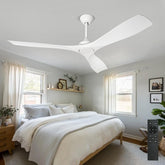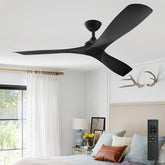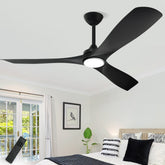Tips for application scenarios of lamps
21 Apr 2022
The lighting mainly follows three principles: anti-glare (not dazzling); consistent color temperature; reasonable layout.
1. Anti-glare (not glare)
The light of the light source is too dazzling and will make people uncomfortable. When arranging the lights, avoid using materials that are easy to reflect light to reduce reflected glare. The projection direction of the light should be as perpendicular to the general horizontal line of sight of the human eye as possible.
When choosing lamps, choose lamps with the following anti-glare standards:
①Select deep hidden light source lamps
②Using the semi-permeable lampshade material to weaken and disperse the excessively concentrated light source. (frosted glass)
③ Use anti-glare accessories (honeycomb grid, etc.) to avoid looking directly at the light source.
2. Consistent color temperature: 3000-4000K is the most suitable color temperature for home
The choice of color temperature is not the best, only suitable, we have to combine the functions of the space according to the design concept and style of the home space
Atmosphere, choose the appropriate color temperature.
In the home, low color temperature can create a relaxed and comfortable ambient light; high color temperature can create a cool light environment, which matches the tough lines in interior design.
The matching of color temperature and illuminance: low color temperature and low illuminance, high color temperature and high illuminance; color temperature and illuminance need to be consistent, and it is best to agree on the color temperature of the whole house, which is related to people's psychological feelings and emotions. Makes people feel uncomfortable.
3. Reasonable layout: The focus of the layout is the layering of lighting, not the whole house.
A home has different areas, and each area is divided according to where the person is. When you find the most lasting demand in each partition, it is the originality of the partition space, and then consider the elements inside, distinguish the primary and secondary, and expand the lighting layout.
Local lighting, general lighting, accent lighting, and decorative lighting are four lighting methods for home lighting. These lighting methods do not have strict boundaries. In many areas, lamps can achieve several lighting functions at the same time.
①Living room
A typical living room is mainly divided into the following main areas: entrance porch, TV wall (TV area), leisure area, decorative paintings (decoration area)
A 5W spotlight/downlight can be used in the entrance, a table lamp or floor lamp can be arranged in the living room sofa and leisure reading area to protect eyesight, several anti-glare downlights can be arranged in the TV area, and downlights, spotlights and tracks can be used in the decorative painting area. The lamp does the focus light painting... (For details, please refer to the sixth issue of the comic lecture lamp)
② bedroom
This area is relatively quiet and sensitive, and has higher requirements for anti-glare lamps.
③ Kitchen lighting
The kitchen is the most active location in the whole home and the hardest hit area with the most lack of lighting design. Most of the family kitchens are only installed with a ceiling lamp, and there will be shadows when washing and chopping vegetables, which is extremely inconvenient.
④ Restaurant
This area is generally dominated by decorative lighting, supplemented by local (basic) lighting, so the requirements for the appearance of lamps are still relatively high.
⑤ Bathroom
First of all, pay attention to moisture-proof, waterproof and anti-glare. The areas that need to be lighted are mainly in front of the bathroom mirror, toilet, bathtub and shower.
1. Anti-glare (not glare)
The light of the light source is too dazzling and will make people uncomfortable. When arranging the lights, avoid using materials that are easy to reflect light to reduce reflected glare. The projection direction of the light should be as perpendicular to the general horizontal line of sight of the human eye as possible.
When choosing lamps, choose lamps with the following anti-glare standards:
①Select deep hidden light source lamps
②Using the semi-permeable lampshade material to weaken and disperse the excessively concentrated light source. (frosted glass)
③ Use anti-glare accessories (honeycomb grid, etc.) to avoid looking directly at the light source.
2. Consistent color temperature: 3000-4000K is the most suitable color temperature for home
The choice of color temperature is not the best, only suitable, we have to combine the functions of the space according to the design concept and style of the home space
Atmosphere, choose the appropriate color temperature.
In the home, low color temperature can create a relaxed and comfortable ambient light; high color temperature can create a cool light environment, which matches the tough lines in interior design.
The matching of color temperature and illuminance: low color temperature and low illuminance, high color temperature and high illuminance; color temperature and illuminance need to be consistent, and it is best to agree on the color temperature of the whole house, which is related to people's psychological feelings and emotions. Makes people feel uncomfortable.
3. Reasonable layout: The focus of the layout is the layering of lighting, not the whole house.
A home has different areas, and each area is divided according to where the person is. When you find the most lasting demand in each partition, it is the originality of the partition space, and then consider the elements inside, distinguish the primary and secondary, and expand the lighting layout.
Local lighting, general lighting, accent lighting, and decorative lighting are four lighting methods for home lighting. These lighting methods do not have strict boundaries. In many areas, lamps can achieve several lighting functions at the same time.
①Living room
A typical living room is mainly divided into the following main areas: entrance porch, TV wall (TV area), leisure area, decorative paintings (decoration area)
A 5W spotlight/downlight can be used in the entrance, a table lamp or floor lamp can be arranged in the living room sofa and leisure reading area to protect eyesight, several anti-glare downlights can be arranged in the TV area, and downlights, spotlights and tracks can be used in the decorative painting area. The lamp does the focus light painting... (For details, please refer to the sixth issue of the comic lecture lamp)
② bedroom
This area is relatively quiet and sensitive, and has higher requirements for anti-glare lamps.
③ Kitchen lighting
The kitchen is the most active location in the whole home and the hardest hit area with the most lack of lighting design. Most of the family kitchens are only installed with a ceiling lamp, and there will be shadows when washing and chopping vegetables, which is extremely inconvenient.
④ Restaurant
This area is generally dominated by decorative lighting, supplemented by local (basic) lighting, so the requirements for the appearance of lamps are still relatively high.
⑤ Bathroom
First of all, pay attention to moisture-proof, waterproof and anti-glare. The areas that need to be lighted are mainly in front of the bathroom mirror, toilet, bathtub and shower.














